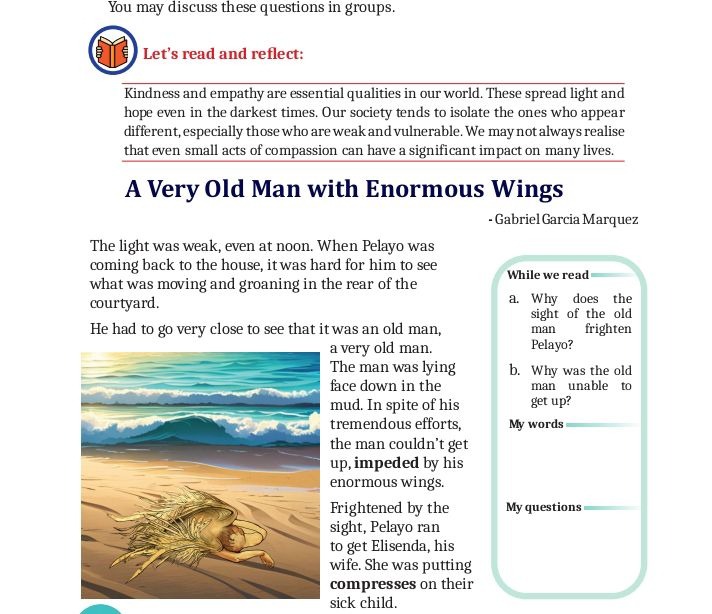Detailed Study note - Night of the Scorpion by Nissim Eziekiel
Introduction to the Poem and the Poet
"Night of the Scorpion" is a renowned poem by Nissim Ezekiel, one of the foundational figures in Indian English poetry. Ezekiel was known for his modern outlook and realistic portrayal of Indian society, often capturing the clash between traditional beliefs and modern thinking. In this poem, he presents a vivid narrative inspired by a real incident from his childhood, blending personal memory with universal themes such as fear, faith, and maternal love. The poem is a reflection on how individuals and communities respond to suffering, and it shows Ezekiel’s ability to present ordinary events in a deeply meaningful way.
Detailed Summary of the Poem
The poem begins with a sudden incident on a rainy night when a scorpion, seeking refuge from the downpour, enters the poet’s house and stings his mother. The poet, who was a child at the time, recalls the dramatic events that followed. As soon as the scorpion disappears into the darkness, the news of the sting spreads quickly in the village. The neighbors come rushing, full of concern but also bringing their own traditional beliefs and superstitions.
They sit around the mother, trying to offer comfort and recite prayers. They believe that every movement of the scorpion’s body would make the poison travel further inside the mother’s veins. They suggest that her suffering might cleanse her soul or reduce her past and future karmic burdens. The villagers light candles and lanterns, search for the scorpion to kill it and thereby stop the poison, and offer advice and blessings to the family. The entire atmosphere is filled with anxiety, confusion, and spiritual chanting.
The poet’s father, described as a skeptical and rational man, takes a different approach. Though usually critical of superstitions, he too is affected by the urgency of the situation. He experiments with various remedies—pouring paraffin oil on the wound and even using incense to burn the toe where the scorpion stung. He also tries powder mixtures and listens to advice from every possible source. Meanwhile, the mother silently bears the pain, which lasts for about twenty hours.
Finally, the pain subsides, not because of any remedy but naturally. In the end, the poet remembers his mother’s words, which carry the deepest emotional weight in the poem: “Thank God the scorpion picked on me and spared my children.” This closing line reflects her selflessness and enduring love, emphasizing the powerful bond between a mother and her children.
Themes
The poem deals with several interconnected themes.
Maternal Love and Sacrifice: The most prominent theme is the unconditional love of a mother, captured in her final words of gratitude that her children were spared.
Faith vs. Rationality: The poem shows the contrast between blind superstition (as seen in the villagers’ beliefs) and scientific reasoning (as shown by the father), neither of which offers a solution.
Fear and Human Reaction: The poem realistically portrays how people respond to danger—with panic, community support, prayer, and action.
Cultural Beliefs and Rituals: The villagers’ responses highlight deeply rooted rural Indian customs and superstitions.
Suffering and Endurance: The mother's quiet tolerance of pain underscores the strength and patience of women, especially mothers.
Poetic Devices
Nissim Ezekiel uses various poetic devices that enhance the depth and intensity of the poem.
Imagery: The poem is rich in visual imagery, such as the “mud-baked walls,” the “diabolic tail,” and the flickering lanterns, which bring the rural setting to life.
Alliteration: The repetition of consonant sounds, such as in “Parting with his poison,” adds musical quality to the verse.
Enjambment: The lines flow into one another without breaks, creating a conversational and realistic tone.
Symbolism: The scorpion symbolizes evil, danger, or fate, while the mother becomes a symbol of selfless love.
Contrast: There is a constant contrast throughout the poem—between light and darkness, superstition and science, fear and calmness, chaos and patience.
Structure and Style
"Night of the Scorpion" is written in free verse without a fixed rhyme scheme, giving it a natural and spontaneous feel. The narrative voice is that of the adult poet looking back on a childhood memory, which brings a mix of emotional detachment and reflective depth. The conversational style allows the poet to recount the incident realistically and effectively. The poem is a single long stanza, but within it are many shifts in tone—from panic to reflection, from fear to love.
Special References and Cultural Context
The poem draws heavily from Indian rural life. The villagers’ behavior and beliefs reflect common rural Indian practices, where science and superstition coexist. Their chanting, lighting of candles, and fear of karma reflect the collective psychology of traditional communities. The father, representing modernity and science, also ends up relying on folk methods, showing the complexity of human behavior when faced with emergencies. Ezekiel, although modern in thought, does not ridicule the villagers; instead, he presents them with empathy and realism.
Conclusion
"Night of the Scorpion" is more than a simple tale of a scorpion sting—it is a powerful exploration of human emotions, beliefs, and relationships. The poem brings together the chaos of a fearful event, the rituals of rural life, the helplessness of modern science, and above all, the quiet heroism of a mother. Through vivid imagery, natural narration, and emotional depth, Nissim Ezekiel crafts a memorable poem that continues to resonate with readers across cultures and generations.




Comments
Post a Comment
Please share your feedback and questions